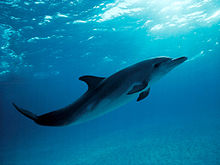
Characteristics
River Dolphin usually grow up to 8 feet (2.44 m) but most are smaller. River dolphins may be white, pink, yellow, brown, gray, or black.[1]Taxonomy
Four families of river dolphins (Iniidae, Pontoporiidae, Lipotidae and Platanistidae) are currently recognized, comprising three superfamilies (Inioidea, Lipotoidea and Platanistoidea). Platanistidae, containing the two subspecies of South Asian river dolphin, is the only currently accepted extant family of Platanistoidea. The four families were classified by Rice (1998)[1] as all belonging to Platanistoidea. Previously, many taxonomists had assigned all river dolphins to a single family, Platanistidae, and treated the Ganges and Indus River dolphins as separate species. With the disappearance of the baiji or Chinese river dolphin in 2006, one of the recently accepted superfamilies, Lipotoidea, has become extinct.River dolphins are thought to have relictual distributions. Their ancestors originally occupied marine habitats, but were then displaced from these habitats by modern dolphin lineages.[2][3] Many of the morphological similarities and adaptations to freshwater habitats arose due to convergent evolution; thus, a grouping of all river dolphins is paraphyletic. Non-South Asian river dolphins are actually more closely related to marine dolphins than to South Asian river dolphins.[4]
A December 2006 survey found no members of Lipotes vexillifer (commonly known as the baiji, or Chinese river dolphin) and declared the species functionally extinct.[5]
The current classification of river dolphins is as follows:[1][6]


Oceanic dolphins are members of the cetacean family Delphinidae. These marine mammals are related to whales and porpoises. They are found worldwide, mostly in the shallower seas of the continental shelves. As the name implies, these dolphins tend to be found in the open seas, unlike the river dolphins, although a few species such as the Irrawaddy dolphin are coastal or riverine.
Six of the larger species in the Delphinidae, the killer whale, pilot (long-finned and short-finned), melon-headed, pygmy killer and false killer whales, are commonly called whales, rather than dolphins; they are also sometimes collectively known as "blackfish".
Characteristics
The Delphinidae are the most diverse of the cetacean families, with numerous variations between species. They range in size from 1.2 m (3.9 ft) and 40 kg (88 lb) (Haviside's dolphin), to 9 m (30 ft) and 10 tonnes (killer whale). Most species weigh between 50 and 200 kg (110 and 440 lb). They typically have curved dorsal fins, clear 'beaks' at the front of their heads, and forehead melons, although exceptions to all of these rules are found. They have a wide range of colors and patterns.[1]Most delphinids primarily eat fish, along with a smaller number of squid and small crustaceans, but some species specialise in eating squid, or, in the case of the killer whale, also eat marine mammals and birds. All, however, are purely carnivorous. They typically have between 100 and 200 teeth, although a few species have considerably fewer.
Delphinids travel in large pods, which may number a thousand individuals in some species. Each pod forages over a range of a few dozen to a few hundred square miles. Some pods have a loose social structure, with individuals frequently joining or leaving, but others seem to be more permanent, perhaps dominated by a male and a 'harem' of females.[1] Individuals communicate by sound, producing low-frequency whistles, and also produce high-frequency broadband clicks of 80-220 kHz, which are primarily used for echolocation. Gestation lasts from 10 to 12 months, and results in the birth of a single calf.

No comments:
Post a Comment
Note: Only a member of this blog may post a comment.